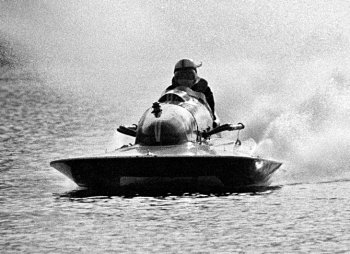|
The three-point
powerboats competing in the Sixties and Seventies as Class Lancia, subsequently
renamed Flaminia 2500, where all powered by the engine of the great Lancia
flagship, suitably modified for nautical competitive events. Providing a neat
match with the Monaco Classic Week and the Flaminia's 50th anniversary, the
Flaminia 2500 has been presented alongside a Flaminia Coupé in the garden of the
Yacht Club of Monaco.
A real jewel of Lancia engineering, the power unit was compact, lightweight and
powerful, and incorporated leading-edge solutions. It was a 6V at 60° unit,
developed from that of the Aurelia, wholly in aluminium with overhead valves
(two per cylinder) actuated by block-mounted camshaft through pushrods and
rockers.
Quiet and reliable, the Flaminia powerplant was initially a 2,500 cc unit, to be
replaced a few years later by a 2,800 cc version. Thus, the second-hand market
was able to supply the brilliant “2.5 litre” of the Flaminia at competitive
prices. It was then that pilots and engineers in nautical circuit competitions –
Italian races were the most popular in Europe with inboard classes from 1,500 to
2,500 cc – decided to install this engine on their boats (the ‘three-point’ was
the wholesale winner in that period, an extremely fast boat on the straight but
very vulnerable when veering) and in particular those of class 2,500 cc,
virtually the F1 of its time.
|
 |
|
A real jewel of Lancia engineering, the power unit
was compact, lightweight and powerful, and
incorporated leading-edge solutions. Quiet and
reliable, the Flaminia powerplant was initially a
2,500 cc unit, to be replaced a few years later by a
2,800 cc version. |
|
|
 |
|
Providing a perfect harmony to the Flaminia's 50th
anniversary and the Monaco Classic Week, the
successful Flaminia 2500 powerboats of the 1960s and
1970s were fondly remembered at the event. |
|
|
The Flaminia engine was installed rear to front relative to
the car configuration, namely with power take-offs on the
pulleys’ end, not on the flywheel end. Racing took place on
two identical 800 meter straights and two 200 meter curves
to the left. To permit veering to the left, the propeller
had to rotate rightward only. There was no electric system
and spark plugs had platinum electrodes (innovative at the
time). The exhaust piping was different too, in order to
maximise power output. In common with production engines
there were the crankshaft, connection rods, pushrods,
rockers and tappets. For the rest there were no restraints.
Engineer and pilot ingenuity resulted in the Flaminia 2500
reaching top speeds of 228 km/h during distance racing.
The strong point that helped secure the success of the
Flaminia engine was its capability to deliver maximum torque
at as low as 4,500 rpm (against the 5,800 rpm of Alfa Romeo
engines). This made for exceptional pickup around the buoy,
subsequently unleashing all the available power on the
straight. Other advantages were reliability and lightweight,
the latter being a very important factor, as maximum weight
of boat plus pilot was not allowed to exceed 370 kg.
|
|
|
|